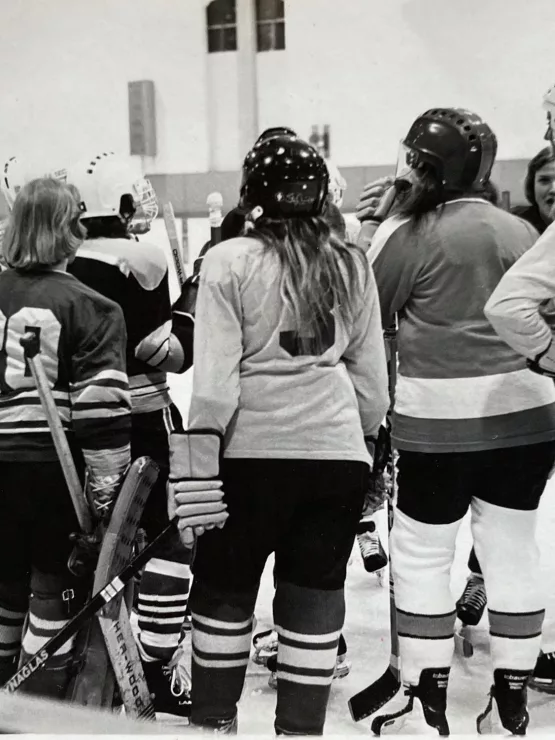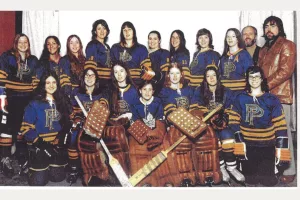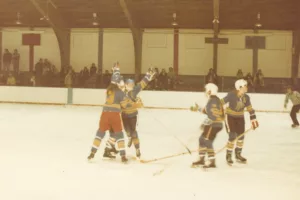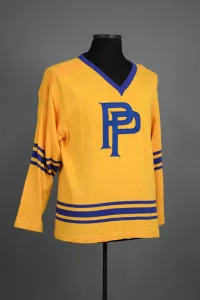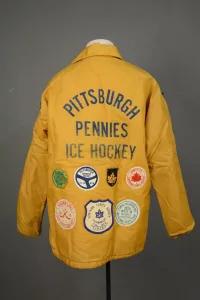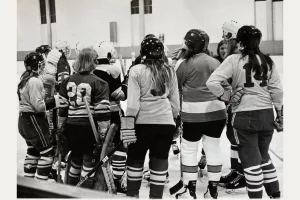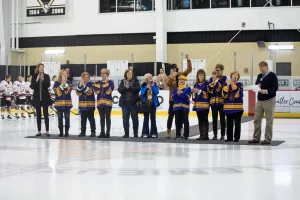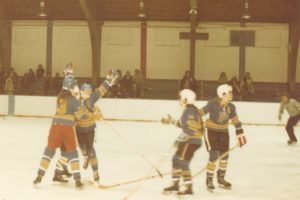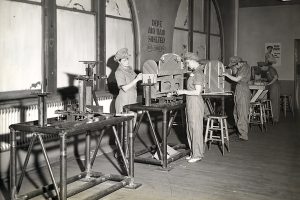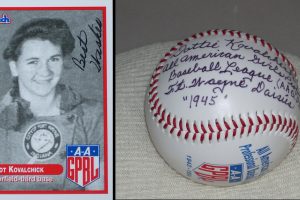Most of the Pittsburgh Pennies weren’t looking to break barriers or change the world when they laced up their skates and took to the ice in 1973, but now 50 years later, they are seen as trailblazers. The Pennies came of age in the era of Title IX when opportunities for girls and women to participate in organized athletics began to expand. The team was homegrown, formed by a small group of young women and some of their parents who came to know each other at the Alpine Arena in Swissvale. A love of the game and a desire to compete initially brought them together. What they created is now recognized as integral to the establishment of competitive hockey for girls in the region.
The Pennies were not the first females to play ice hockey in the region. Hockey historian Bob Grove has found evidence of exhibition games played by women in the early 20th century, though there is no record of any organized league play.1 To date, the Pennies seem to be the first regional team in the modern era to form and sustain competitive play over a number of years. By no means an easy task, the team benefitted from committed players and families who recruited members, found qualified coaches, and raised the funds necessary to keep a team on ice.
In the 1970s all ice hockey players, male and female, were challenged by the lack of ice arenas in the region. While two outdoor rinks in North and South Parks hosted youth leagues for boys in the 1960s, it was the building of indoor arenas such as Rostraver (1965) and Alpine (1967) that began to open up the game. 2 Without available ice, designed not just for skating but for the game, feeder programs could not generate the players needed to sustain hockey on the high school and college level. And existing teams at all levels competed for the valuable ice time that did exist.
Women such as Barbara DeShong (now Greil) who started out skating on a pond in her Wilkinsburg neighborhood and at the Alpine Arena were among the first five players who founded the Pennies. Mariellen Steirhelm and her husband Joe helped organize the team. They placed ads in The Pittsburgh Press and left recruiting brochures at rinks in the region to recruit players.3 Barbara, who played center, and sometimes wing, loved the game, and stayed involved after her playing days, coaching her sons’ floor and then ice hockey teams. Other women, such as Jean Lombardi followed similar routes to the Pennies. She grew up competing against her brothers on the frozen pond of her family’s farm in Fox Chapel. When a professor at the University of Pittsburgh suggested she join the men’s team she declined, not wanting to be a token girl. Instead, Jean sought out like-minded women and helped lead this new enterprise in female sport.
The team grew from its first few members to a roster of about 30. As the Pennies expanded and became more organized the team attracted players of all ages excited to refine their on-ice skills in a competitive environment. In 1974, the Pennies featured two nine-year old players, Kathleen Worrall (now Fattizzi) and Amy Hughes, the team’s goalie.4 Hughes’ father Jim signed on to coach the team, providing much needed developmental structure to the group. One of his challenges became finding teams to play against. Initially the Pennies held intrasquad scrimmages at Alpine Arena every Sunday and occasionally competed against boys’ high school teams. But within a year of being founded, the Pennies were playing against women’s teams from Canada. They played a preliminary game during the Pitt Invitational college hockey tournament in November of 1974, losing a close one to the King City team from Ontario 5-4. A week earlier, they had opened their season against Havelock, another team from Ontario.5 With no other women’s teams in the region, the Canadians provided the Pennies with an opportunity to test their skills against established players. By the mid-1970s the team competed in a Mid-Atlantic League and travelled to Buffalo, Philadelphia, and Canada for tournament play.
Though the team disbanded in 1979, stressed by the constant need to fundraise and attract new members, it had a major impact on the women who participated and on the sport. Players such as Shelley Starkey, who joined the team in 1973 at age 12, note the confidence and sense of empowerment the Pennies gave her, describing it as a “life changing experience.”6 Others such as Greil and Lombardi continued to participate in sports and coach both boys and girls, leading a new generation in sport.
While few of the Pennies see themselves as pioneers, they demonstrated the ability of women to compete and succeed in ice hockey and unknowingly opened the door to the high school, club, college, and elite amateur teams training players and offering a range of competitive opportunities in the region today. In 2021-22 the Pennsylvania Interscholastic Hockey League (PIHL) formed its first competitive structure for high school girls’ hockey in the region. The League fields six teams, offering girls the opportunity that the Pennies never had – to compete against girls’ teams here in Western Pa. Elite club teams also now provide the chance for female athletes to travel and play across the country, showcasing their skills to college and national team coaches. Fifty years after the Pennies first took to the ice, they serve as examples for how equality in sport can be achieved.
About the Author
Anne Madarasz, Chief Historian and Director of the Western Pennsylvania Sports Museum
